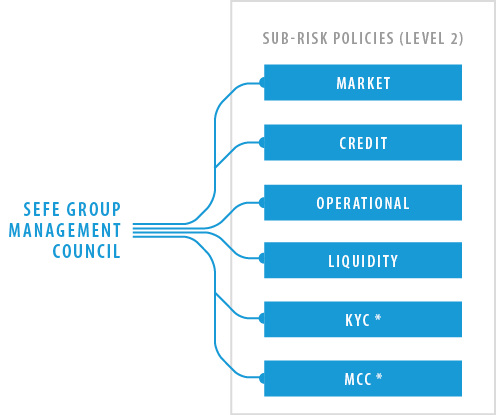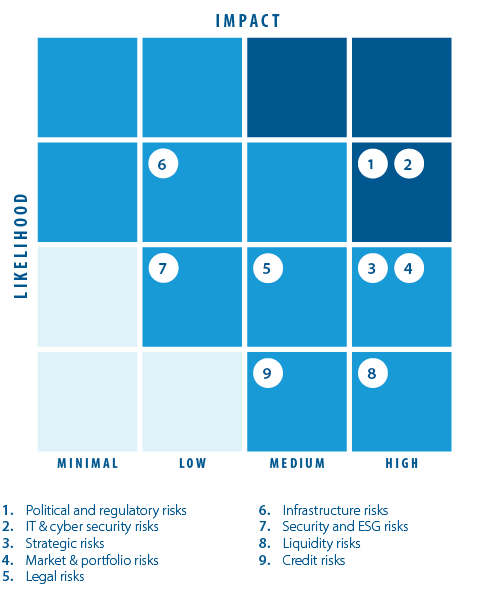Opportunities for SEFE Group
The SEFE Group is strategically well positioned to make optimal use of its infrastructure assets and its LNG portfolio and to expand its trading and sales activities. The balanced sales and sourcing strategy as well as the Group’s expertise in the global LNG and European gas and power markets form the basis for long-term growth and enable a dynamic response to short-term market opportunities. This makes it possible to build long-term customer relationships and exploit sourcing advantages. Established relationships with business partners and a diversified customer base also enable the expansion of the pipeline gas and LNG portfolios through medium and long-term transactions. In the short term, the SEFE Group can use the flexibility of its portfolios to generate margins and create added value for shareholders and customers.
In the medium term, the SEFE Group has opportunities to drive growth and strengthen its market position. The introduction of digital trading and the implementation of algorithmic strategies will provide the Group with the opportunity to optimise its trading activities and reduce operating costs. The expansion of the portfolio of embedded power purchase agreements, the development and trading of green certificates and the entry into new commodity markets open up opportunities for diversifying the Group’s revenue. This includes metal trading, which also provides access to the important raw materials that are a prerequisite for technologies related to the energy transition.
The SEFE Group’s long-term strategy is in line with the goals of ensuring energy security and supporting the energy transition. It is therefore actively involved in shaping the hydrogen market, developing global supply chains and supporting the structuring of European markets. Key projects in this regard include Flow – making hydrogen happen, which envisages the development of hydrogen transport capacity in Germany and neighbouring countries; AquaDuctus, which aims to enable offshore hydrogen production and transport from wind farms in the North Sea; and the Jemgum hydrogen underground storage facility, which is intended to provide underground salt caverns and a hydrogen processing plant. In addition, the Group’s activities focus on global and local partnerships to ensure the sourcing and marketing of cost-effective hydrogen on a large scale via the future hydrogen core network and on the development of local and flexible decarbonisation solutions. Given the dynamic development in the technological, economic and regulatory framework, the Group is examining various ways to achieve these goals.
The SEFE Group’s integrated trading and sales model puts it in a good position to support its customers in the energy transition. With a broad presence in Northwest Europe, the SEFE Group’s sales activity is already contributing to a secure energy supply. This broad access offers the Group suitable opportunities to identify future developments in the field of green transformation and digitalisation in the market and to quickly scale innovations for customers.
The SEFE Group’s diverse competencies also enable the effective management of risks and the exploitation of opportunities in volatile markets. The Group relies on advances in trading, portfolio management and product innovation to ensure long-term growth and competitiveness.
Risk management system at the SEFE Group
The SEFE Group’s risk management, which is an integral component of its business processes, adapts dynamically to market conditions, regulatory changes, strategic priorities and overarching business objectives. The Group addresses financial and non-financial risks through mechanisms for risk identification, evaluation and control, and takes risk mitigation measures where necessary.
The SEFE Group operates a consistent risk management system, taking into account the organisation-wide unbundling requirements. This system is crucial for achieving the Group’s corporate objectives and enables consistent monitoring of operational and financial activities.
In 2024, the Group began to integrate ESG-related factors into its risk management framework to address the environmental and social impacts of its activities. The Group is currently in the process of integrating into its risk management framework the requirements of the Corporate Sustainability Reporting Directive (CSRD).
Risk management
The SEFE Group’s risk management system is documented in internal guidelines and methodologies and ensures a structured approach to risk management. The SEEHG Supervisory Board determined the SEFE Group’s overarching risk policy and risk appetite. They are specified and implemented through subordinate
risk policies and supporting documents by the Management Council – a body consisting of key management personnel – and the SEFE Group’s Risk Management function.
The SEFE Group’s risk appetite defines quantitative limits for financial risks and contains qualitative statements on risk tolerance for non-financial risks.
The two risk committees established by the Supervisory Board and the Management Council are responsible for monitoring compliance with the limits defined in the SEFE Group’s risk appetite, managing improvements to the risk management system and advising the respective bodies on other topics related to risk management.
The SEFE Group’s risk management system is set out in the SEFE Group Risk Policy:
The risk management system is implemented through the risk policy and other supporting documents, which were approved by the Management Council and/or the SEFE Group’s Risk Management function.
The operational and supporting units act as risk owners and manage risks within their operational activities. The SEFE Risk Management function acts as a second line of defence and provides advisory services, independent control functions, reporting and monitoring, thereby ensuring consistent application of risk policies.
Risk identification and assessment
As shown in Figure 2, the risk exposures for the SEFE Group are classified into nine categories. The classification of each risk category is determined by a qualitative assessment based on the average assessment of all individual risks within that category. The risk map below depicts the risk situation of the SEFE Group.
Potential impacts of risks in the areas of finance, reputation, ESG and business operations are classified on a scale from minimal to high. Small and temporary impacts of less than EUR 5 million are considered minimal, while high impacts are above EUR 250 million and pose serious challenges.
The likelihood of risk occurrence is assessed on a scale from minimal (below 5 %) to high (above 60 %) based on historical data and probabilities. The assessment of the possible impacts and probabilities form the risk management framework that enables the Group to set priorities and manage risks effectively.
The SEFE Group distinguishes between financial and nonfinancial risks in order to take into account the direct impact of certain risks on the Group’s financial position.
Financial risks
The SEFE Group’s business activities result in market and portfolio risks, as well as credit and liquidity risks. The Group has developed numerical models to quantify and control these risks within the parameters defined in the risk appetite.
Market and portfolio risks:
The SEFE Group accepts a limited market risk, which results from both price volatility in trading and sales as well as from the portfolio of long-term contracts. The Group uses a market value-at-risk (MVaR) approach based on a Monte-Carlo simulation to assess its market risk, which is affected primarily by commodity and derivative prices as well as foreign exchange rates. To complement daily MVaR monitoring, the Group uses additional methods and controls, such as stress tests, sensitivity analyses and risk limits.
Factors that pose significant challenges for risk management include LNG contracts, whose margins are influenced by long-term price trends, as well as the emerging markets for hydrogen and low-emission products. In 2024, the SEFE Group introduced a scenario-based long-term risk framework to further improve the evaluation, monitoring and management of such risks.
Liquidity risks:
The Group matches its financial commitments with the available liquidity to meet its financial requirements. The liquidity risk management process is based on the evaluation of potential negative deviations from planned cash flows. These can arise from margin calls as well as from modelled realisations of market, credit and operational risks. The Group identifies maturity-dependent liquidity risks and ensures that these are covered by available liquidity, including committed financing lines.
The Group’s financial resilience is achieved by optimising working capital and stabilising cash flow. In addition, SEFE’s committed KfW credit line represents a significant financial buffer and considerably reduces the risk of liquidity bottlenecks.
Credit risks:
Credit risks, which result from the non-performance of contractual commitments by counterparties, pose threats to the financial performance of the SEFE Group. These risks arise mainly from the Group’s sales and trading activities and are managed effectively through a comprehensive framework governing credit risk management.
In 2024, the SEFE Group’s overall exposure to credit risk decreased compared to the previous year. This improvement resulted from several factors, including a decrease in the overall exposure due to falling commodity prices and lower market volatility, as well as upgrades in the credit ratings of insurers, which cover a large part of the retail portfolio.
The Group’s approach to credit risk management includes the assessment of counterparties, processes for monitoring credit exposures and the application of credit limits. These controls ensure that exposures remain within acceptable limits.
Non-financial risks
The SEFE Group manages non-financial risks through central controls based on the qualitative risk definitions of risk appetite. Operational risks are minimised to an acceptable level taking economic efficiency into account. Strategic risks are integrated into decision-making processes to limit their impact. The Group also proactively implements measures to minimise health, safety and environmental (HSE) risks. A zero-tolerance policy applies to regulatory violations.
The following section provides an overview of the SEFE Group’s approach to managing non-financial risks. It also describes the significant developments during the reporting period in the respective risk categories.
Political and regulatory risks:
The SEFE Group operates in a complex and dynamic environment characterised by rapidly evolving political, regulatory and legal requirements. Sanctions risks associated with LNG sourcing can have a major financial impact. Other risks include potential disruptions to trading strategies as well as regulatory requirements such as reducing methane emissions. These risks could require additional investments in infrastructure and higher operating expenses.
Geopolitical risks can destabilise supply chains or restrict LNG imports from existing contracts. In addition, the expiration of Brexit-related exemptions in 2026 may create new regulatory requirements for the Group’s UK-based trading activities.
While the SEFE Group actively monitors global political and regulatory developments, it also takes measures to mitigate potential impacts by working with policymakers and industry associations and by diversifying its supply portfolio.
IT and cyber security risks:
The Group is exposed to risks related to the availability, security and adequacy of its IT systems and technological resources. Increasing cyber threats exploit vulnerabilities and thus endanger business continuity. This results in the risk of significant losses and operational disruptions.
The SEFE Group is addressing these risks through a comprehensive IT initiative to increase system resilience. This initiative includes modernising IT resources and improving network security.
The Group has prioritised the development of robust disaster recovery procedures and high availability capabilities and is coordinating the group-wide implementation of redundancy systems to ensure operational continuity despite IT outages. In addition, advanced threat detection systems have been introduced to detect potential vulnerabilities in real time.
These measures ensure that the SEFE Group’s technological environment is secure, modern and able to support critical business processes. At the same time, they reduce the likelihood and impact of cyber attacks, system failures and operational disruptions.
Strategic risks:
The Group fulfils its mandate to safeguard the security of supply by concluding long-term gas supply contracts and securing regasification capacity. The interactions between the requirements of supply security, weaker gas demand in Europe and the accelerated energy transition pose significant challenges. The benefits of long-term supply contracts, for example, could be offset by the shift to renewable energies, thereby negatively affecting trading revenue through lower prices and reduced volatility.
The restrictions imposed by the EU Commission as part of the transfer of the ownership of the Group to the German government reduce the range of activities available to the Group to achieve its strategic objectives.
The long-term profitability of gas transport and storage capacity is subject to significant uncertainty because gas is increasingly being replaced by alternative energy sources. The investments planned by the SEFE Group to convert its infrastructure for hydrogen entail considerable risks due to the early development stage of the hydrogen market and uncertainties regarding its long-term commercial profitability.
In the Sales business area, the Group faces ongoing challenges in keeping the existing business resilient while meeting growing customer demands for digitalisation, decarbonisation, compliance with high ESG standards and adaptation to the energy transition. The Group addresses these challenges by performing ongoing assessments of the business environment and by adapting its strategy to market conditions and operational needs.
Legal risks:
The Group has successfully settled the arbitration proceedings related to the non-supply of natural gas as a result of the suspension of deliveries caused by Russian sanctions against SEFE Group companies. Legal risks also arise from potential ahead-of-schedule contract terminations and other legal disputes. In addition, allegations of hidden commissions to brokers or disputes over LNG transport contracts pose significant risks that may lead to regulatory investigations, legal penalties and reputational damage. The Group makes provisions for potential financial commitments arising from pending proceedings, provided that their occurrence is deemed probable.
Infrastructure risks:
The operation of underground gas storage facilities and the increased involvement in natural gas transport following the acquisition of an additional investment in WIGA during the financial year entail risks related to the performance and reliability of the infrastructure. These risks result mainly from potential operational failures due to wear and tear, corrosion or external factors.
To mitigate infrastructure risks, the SEFE Group operates a comprehensive risk management framework covering the risks arising from operational safety, system resilience and regulatory compliance. Key measures in this regard include advanced monitoring and quality assurance, enhanced cyber security measures, physical security protocols, and training on crisis management and sabotage prevention.
The targeted full compliance with industry regulations and legal standards aims to ensure operational safety while reducing the exposure to compliance-related risks.
Security and ESG risks:
The SEFE Group’s commitment to ambitious ESG initiatives entails risks. A key challenge is to reconcile energy security with sustainability requirements.
HSE-specific risks include ensuring the safety and well-being of employees and contractors, especially during infrastructure measures. Physical climate risks, such as extreme weather events, could additionally disrupt these processes, increase operating costs and shorten the lifespan of assets.
The Group proactively addresses ESG risks through a comprehensive framework that focuses on compliance, stakeholder engagement and continuous improvement.
In addition to the aforementioned risks, the SEFE Group monitors other risk categories that are not listed separately. These include the accounting, personnel and transformation risks common in the energy industry, those compliance and operational risks which are classified as minimal, and any risks that may arise from the upcoming privatisation of the Group. The Group manages these risks in the same way as it manages other non-financial risks. It does not, however, apply special features that surpass the industry standard.
Overall assessment of opportunities and risks
The opportunities and risks of the SEFE Group reflect the changing dynamics of the energy sector, which is characterised by the global transition to green energy and the development of new technologies. As the industry changes, the Group faces the strategic challenge of aligning its portfolio of long-term gas supply contracts with the growing demand for sustainable solutions. In addition, the energy transition requires significant investments to convert the existing gas infrastructure for hydrogen.
Major infrastructure projects underscore the Group’s commitment to innovation in hydrogen and decarbonisation. The hydrogen market is in an early phase, which brings with it uncertainties regarding the market development, regulatory frameworks and technological advances. These factors contribute to a complex risk landscape, but also offer significant long-term growth potential.
Despite these challenges, the SEFE Group benefits from a number of strategic opportunities. The LNG portfolio increases the security of energy supply through medium and long-term contracts. The SEFE Group’s infrastructure assets contribute to the resilience of the business model through stable margins.
The Group-wide integrated strategy to expand the energy portfolio through targeted investments in renewable energy sources as well as in power and metal trading opens up further growth opportunities. The Group believes it is well positioned to adapt to industry changes and exploit future market opportunities because it can leverage its infrastructure assets and rely on its extensive market expertise and a high commitment to sustainability.
Although strategic risks exist regarding the energy transition, the SEFE Group believes these risks are not a threat to its continued existence as a going concern. The Group is positioning itself as a key player in shaping the future of the energy sector through its commitment to offset risks with strategic investments in hydrogen and market expansion.



